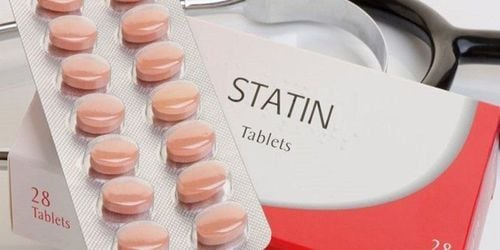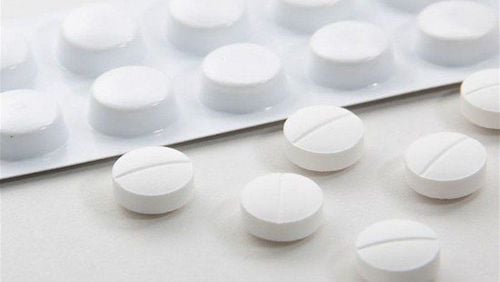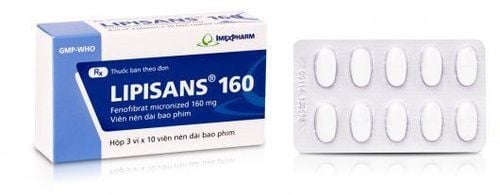This is an automatically translated article.
Prevasel contains the active ingredient pravastatin 10mg. Pravastatin has a lipid-lowering effect by reducing cholesterol biosynthesis by reversibly inhibiting 3-hydroxy-3 methylglutaryl coenzyme A (HMG-CoA), the enzyme that catalyses the conversion of HMG-CoA to mevalonate, which is involved in these steps. the first step in cholesterol synthesis.
1. What are the effects of prevasel?
Prevasel contains the active ingredient pravastatin 10mg. Pravastatin belongs to the statin group, which reduces cholesterol biosynthesis by reversibly inhibiting 3-hydroxy-3 methylglutaryl coenzyme A (HMG-CoA), the enzyme that catalyses the conversion of HMG-CoA to mevalonate. the first steps of cholesterol synthesis. Prevasel has the following effects:
Treatment of hypercholesterolemia or mixed dyslipidemia when the patient is unresponsive to dietary changes and other non-pharmacological measures Helps prevent heart disease cardiovascular disease, reducing morbidity and mortality from cardiovascular diseases in patients with high blood cholesterol levels and risk factors such as smoking, obesity, high blood sugar, high blood pressure, low blood pressure, and low cholesterol. motor. Reduced risk of morbidity and mortality in heart disease patients with a history of myocardial infarction or unstable angina Post-transplant reduction in lipids in patients on immunosuppressive therapy after muscle transplantation mandarin.
2. Pharmacokinetics of the drug prevasel
Pravastatin is administered orally and is rapidly absorbed, with peak serum concentrations occurring 1 to 1.5 hours after oral administration. On average 34% of the dose was absorbed, with an absolute bioavailability of 17%. Gastrointestinal food reduces bioavailability, but lipid-lowering effects are similar whether taken 1 hour before or 1 hour after a meal. Pravastatin concentrations, including area under the curve (AUC), maximum plasma concentrations, and minimum concentrations are dose proportional. Approximately 50% of pravastatin is bound to plasma proteins. The volume of distribution of the drug is about 0.5 l/kg. Small amounts of pravastatin may be secreted into breast milk. Approximately 20% of the administered dose is excreted in the urine and 70% in the feces. The half-life of pravastatin is approximately 1.5 - 2 hours.
3. How to take and dose of prevasel
3.1 How to use: Take orally, the patient can take it with or without food, preferably in the evening.
3.2 Dosage: Dosage varies according to blood lipid levels, disease severity, and patient response. The reference dose is as follows:
Adults:
Hypercholesterolemia: 10 - 40 mg/time/day. A therapeutic response is achieved within 1 week and a full dose effect is achieved within 4 weeks, therefore periodic lipid determinations must be performed and dose adjusted accordingly. The maximum dose is 40 mg. Cardiovascular disease: The maintenance dose is usually 40 mg/time/day. Post-transplant dosing: After organ transplantation, an initial dose of 20 mg/day is recommended in patients receiving immunosuppressive therapy. Depending on the response of lipid parameters, the dose may be adjusted up to 40 mg under strict medical supervision. Children and adolescents aged 8 to 18 years with heterozygous familial hypercholesterolemia:
Children 14-18 years old: 10-40mg/day Children 8-13 years old: 10-20mg/ day
4. Contraindications to the drug prevasel
Prevasel is contraindicated in the following cases:
Patients with liver disease or laboratory tests showing abnormal liver function Pregnant and lactating women. Are taking the following drugs: gemfibrozil, other fibrate-lowering cholesterol, high-dose niacin (> 1 g/day), colchicine, drugs for HIV and hepatitis C virus (HCV) any ingredient in the medicine
5. Undesirable effects of prevasel
During the use of prevasel, patients may experience some unwanted side effects:
Frequency > 10%:
Neuromusculoskeletal: Musculoskeletal pain Respiratory: Upper respiratory tract infection Frequency 1 to 10%:
Cardiovascular: Angina pectoris, edema, flushing Dermatology: Alopecia, urticaria Endocrine and metabolic: Changes in libido, weight gain Digestive: Gastrointestinal disorders Birth sex: Cystitis, sexual disorders Hypersensitivity: Hypersensitivity reactions Nervous system: Insomnia, memory impairment, myasthenia gravis, neuropathy, sleep disturbance, dizziness Respiratory: Cough Frequency < 1%:
Neuromusculoskeletal: Myopathy
Frequency not determined:
Liver: Increase in serum alanine aminotransferase, increase in serum aspartate aminotransferase Dermatologic: Rash multiforme, skin changes (including hair/nail changes, discoloration, dry mucous membranes, nodules), photosensitivity, Stevens-Johnson syndrome, toxic epidermal necrolysis Endocrine and transfer gynaecomastia: gynaecomastia, thyroid dysfunction Gastrointestinal: Abdominal pain, constipation, pancreatitis Genitourinary system: Dysuria, nocturia, dysuria Hematology: Eosinophilia, hemolytic anemia , increased erythrocyte sedimentation rate, purpura Liver: acute hepatotoxicity, cholestatic jaundice, fulminant hepatic necrosis, cirrhosis, liver failure, liver cancer, hepatitis, increased serum transaminases, liver infection Fat Hypersensitivity: Anaphylaxis, angioedema Immune: Immune-mediated necrotizing myopathy Nervous system: Chills, cognitive dysfunction (reversible; including memory loss, confusion, cranial nerve disorders (including facial paralysis), irritability, nightmares, peripheral nerve palsy Respiratory: Shortness of breath, interstitial lung disease
6. Notes when using prevasel 10
During the use of prevasel, patients should be aware of:
Diabetes: Increased HbA1c and fasting blood sugar have been reported with HMG-CoA reductase inhibitors. However, the benefits of statin therapy far outweigh the risk of dysglycemia. Myopathy, rhabdomyolysis: Discontinue treatment in any patient with markedly elevated creatine phosphokinase levels (>10 times ULN) or if myopathy is suspected/diagnosed. Hepatic impairment: Use with caution in patients who consume large amounts of ethanol and/or have a history of liver disease. Dosage adjustment may be necessary in some patients with hepatic impairment. Patients with impaired renal function, hypothyroidism, personal or family history of hereditary myopathy, history of myopathy due to previous statin or fibrate use, history of liver disease and/or heavy alcohol consumption It is necessary to inform the doctor before treatment with prevasel 10 In the composition of the drug contains lactose. Therefore, patients with rare hereditary problems of galactose intolerance, the Lapp lactase deficiency or glucose-galactose malabsorption should not take prevasel. Elderly: Use with caution in elderly patients, as these patients are susceptible to myopathy. Surgical Patients: Based on current research and clinical guidelines, HMG-CoA reductase inhibitors should be continued in the perioperative period for cardiac surgery. Preoperative discontinuation of statin therapy is associated with an increased risk of heart disease and death. Drug Overdose: Currently, data on symptoms of overdose with pravastatin are limited. Therefore, when taking an overdose of pravastatin, the patient should immediately notify the doctor for monitoring and timely handling measures when necessary. Effects on ability to drive and use machines: There are no studies to determine the effect of pravastatin on the ability to drive and use machines. Patients should be aware that dizziness and visual disturbances may occur during prevasel treatment. Pregnancy: Prevasel is contraindicated during pregnancy. Patients should stop taking the drug immediately if pregnancy is detected, Lactation: pravastatin is contraindicated in nursing women. The above is general information about prevasel 10. Note that this information is not a substitute for medical advice. Therefore, patients should consult with their doctor, medical staff before taking the drug.
Please dial HOTLINE for more information or register for an appointment HERE. Download MyVinmec app to make appointments faster and to manage your bookings easily.













